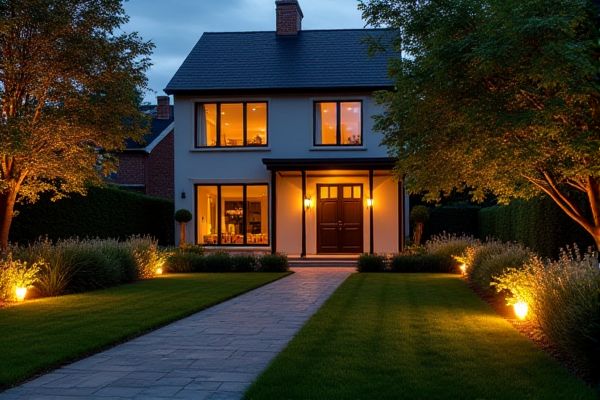
LED garden lights offer energy efficiency, longer lifespan, and cooler operation compared to halogen garden lights, which consume more power and generate heat. Discover how choosing the right lighting can enhance Your garden's ambiance and safety by reading the rest of the article.
Table of Comparison
| Feature | LED Garden Lights | Halogen Garden Lights |
|---|---|---|
| Energy Efficiency | High - Uses up to 80% less energy | Low - Consumes more power |
| Lifespan | Long - 25,000 to 50,000 hours | Short - 2,000 to 4,000 hours |
| Heat Emission | Low - Minimal heat generated | High - Produces significant heat |
| Brightness | Bright with adjustable color temperature | Bright with warm color tone |
| Durability | High - Resistant to shocks and weather | Moderate - More fragile and heat-sensitive |
| Initial Cost | Higher - Costlier upfront | Lower - Budget-friendly initial price |
| Maintenance | Low - Rare replacements needed | High - Frequent bulb changes required |
| Environmental Impact | Eco-friendly - Low energy and no hazardous materials | Less Eco-friendly - Higher energy use, mercury content |
Introduction to Garden Lighting Solutions
LED garden lights offer energy-efficient, long-lasting illumination with a variety of color options and low heat emission, making them ideal for sustainable outdoor lighting solutions. Halogen garden lights provide brighter, warm-toned light but consume more energy and generate significant heat, leading to higher operational costs. Your choice between LED and halogen lighting impacts energy use, maintenance frequency, and overall ambiance in your garden space.
What Are LED Garden Lights?
LED garden lights are energy-efficient lighting fixtures that use light-emitting diodes to illuminate outdoor spaces with minimal power consumption. These lights offer longer lifespans, reduced heat emission, and enhanced durability compared to traditional halogen garden lights, making them ideal for sustainable and cost-effective landscaping. Advanced LED technology also provides customizable color temperatures and brightness levels, improving aesthetic appeal and functionality in garden settings.
What Are Halogen Garden Lights?
Halogen garden lights use halogen gas-filled bulbs that produce bright, white light through tungsten filament heating, offering high color rendering and instant illumination. These lights consume more energy and generate significant heat compared to LED garden lights, which utilize semiconductor diodes for efficient, long-lasting lighting. Halogen garden lights tend to have shorter lifespans and higher maintenance costs, making them less environmentally friendly than their LED counterparts.
Energy Efficiency Comparison
LED garden lights consume significantly less energy than halogen garden lights, using up to 80% less electricity while providing comparable brightness. Their advanced semiconductor technology converts most of the energy into light rather than heat, which reduces power waste and lowers your energy bills. Choosing LED garden lights enhances sustainability and ensures long-term energy savings compared to the energy-intensive halogen alternatives.
Brightness and Color Temperature Differences
LED garden lights offer a wider range of brightness levels and color temperatures, allowing for customizable ambiance from cool white to warm yellow tones. Halogen garden lights typically provide a consistent, warm white glow with higher brightness but consume more energy and emit more heat. You can achieve energy-efficient illumination with LEDs while adjusting color temperature to suit your outdoor space's mood and functionality.
Lifespan and Durability
LED garden lights offer a significantly longer lifespan, typically lasting up to 25,000 to 50,000 hours compared to halogen garden lights, which generally last around 2,000 to 4,000 hours. The durability of LED lights is enhanced by their solid-state construction, making them more resistant to shock, vibrations, and weather conditions, whereas halogen bulbs are more fragile due to their glass components and filament design. This greater lifespan and robustness make LED garden lights a more cost-effective and reliable choice for long-term outdoor illumination.
Installation and Maintenance Requirements
LED garden lights require minimal installation effort, often featuring plug-and-play designs with low voltage wiring that ensures safety and energy efficiency. Unlike halogen garden lights, which demand more frequent bulb replacements and careful handling due to higher heat output, LEDs offer longer lifespans and reduced maintenance costs. Choosing LED garden lights over halogen can simplify your outdoor lighting setup and enhance durability with less upkeep.
Cost Analysis: Upfront and Long-Term
LED garden lights have a higher upfront cost compared to halogen garden lights but significantly lower energy consumption, resulting in substantial long-term savings on electricity bills. Halogen lights incur higher maintenance and replacement costs due to shorter bulb lifespan, typically around 2,000 hours, whereas LEDs can last up to 25,000 hours or more. Investing in LED technology ultimately reduces total ownership costs by minimizing energy usage and replacement frequency.
Environmental Impact
LED garden lights consume significantly less energy than halogen garden lights, resulting in a lower carbon footprint and reduced greenhouse gas emissions. Their longer lifespan decreases waste and the need for frequent replacements, contributing to less environmental pollution. Choosing LED garden lights supports sustainable gardening practices by minimizing energy use and environmental impact.
Which Garden Light Is Best for You?
LED garden lights offer superior energy efficiency, longer lifespan averaging 25,000 to 50,000 hours, and lower heat output compared to halogen garden lights, which typically last around 2,000 hours and consume more electricity. Halogen lights provide a warmer, brighter glow favored for traditional aesthetics but may increase energy costs and heat buildup in outdoor spaces. Choosing the best garden light depends on your priorities for energy savings, maintenance frequency, and desired ambiance in your outdoor environment.
 homyna.com
homyna.com